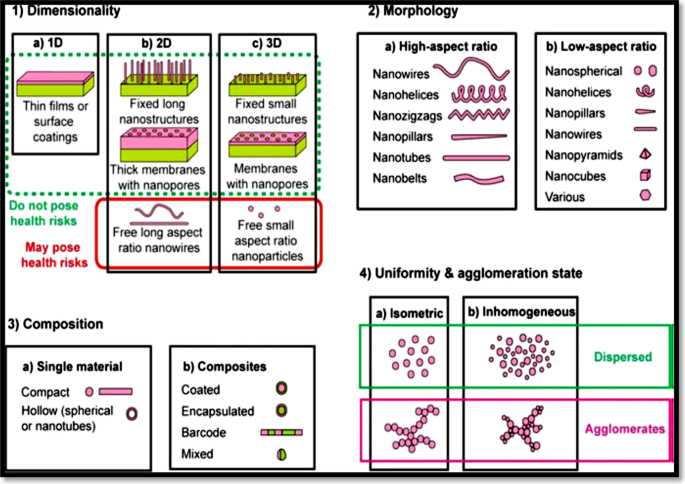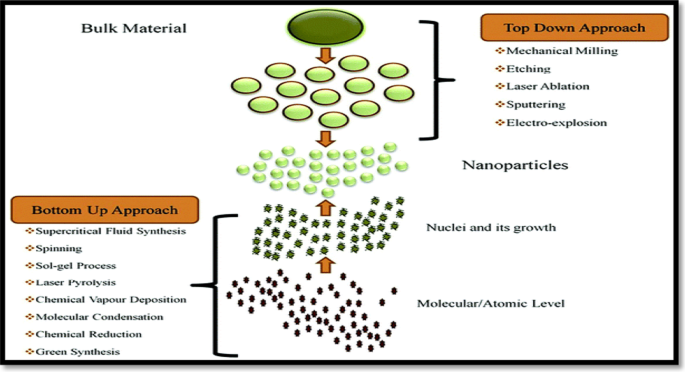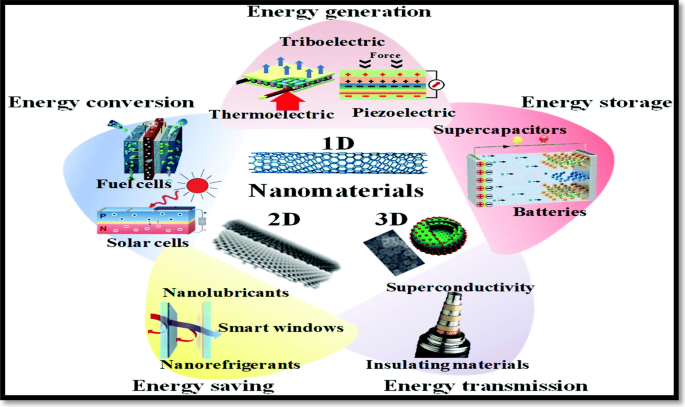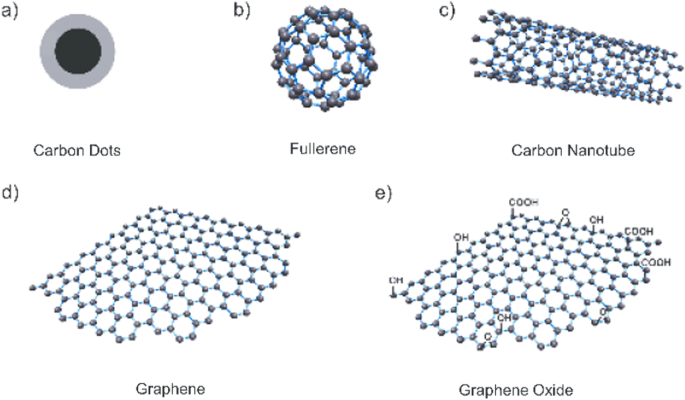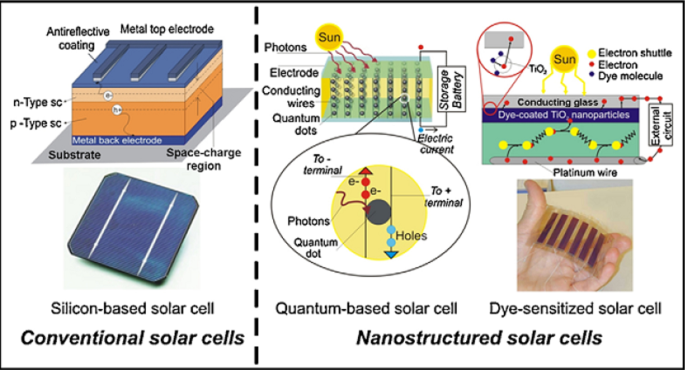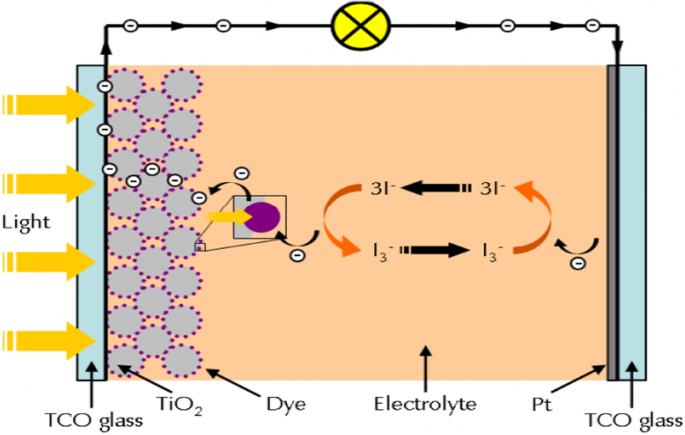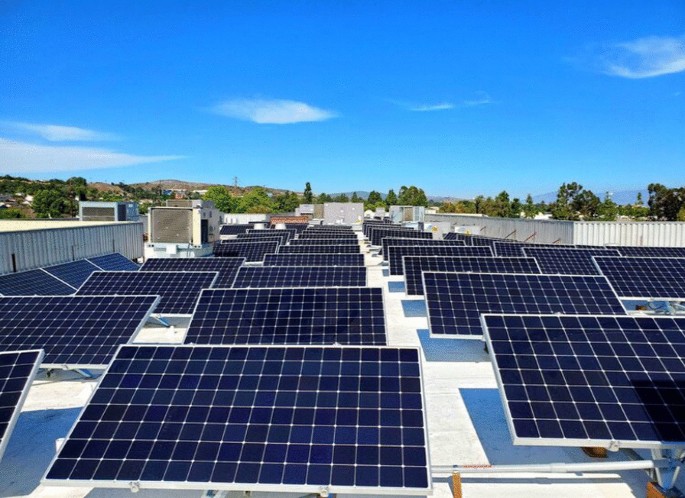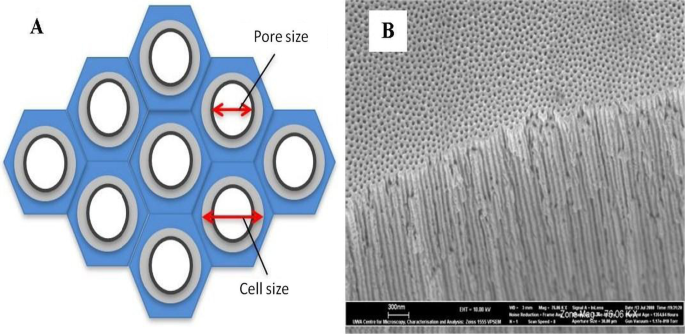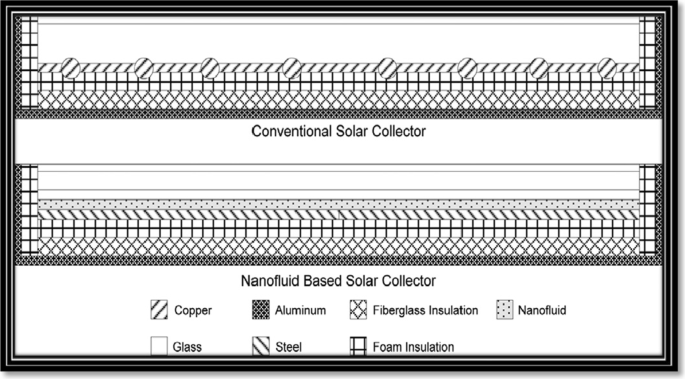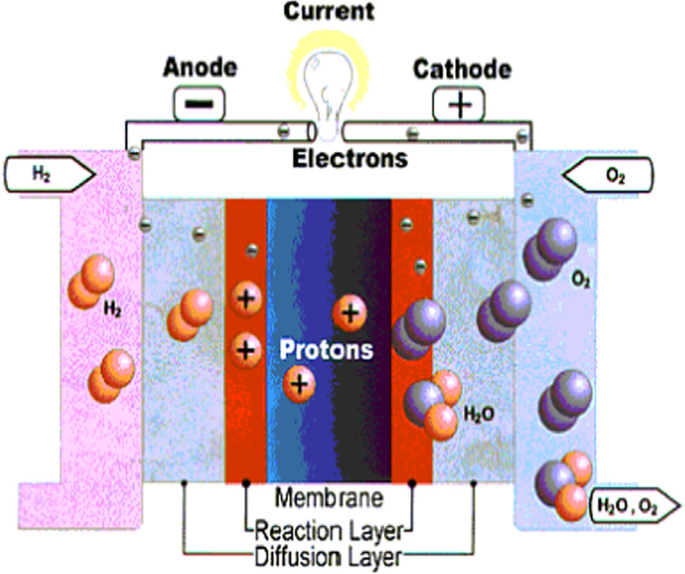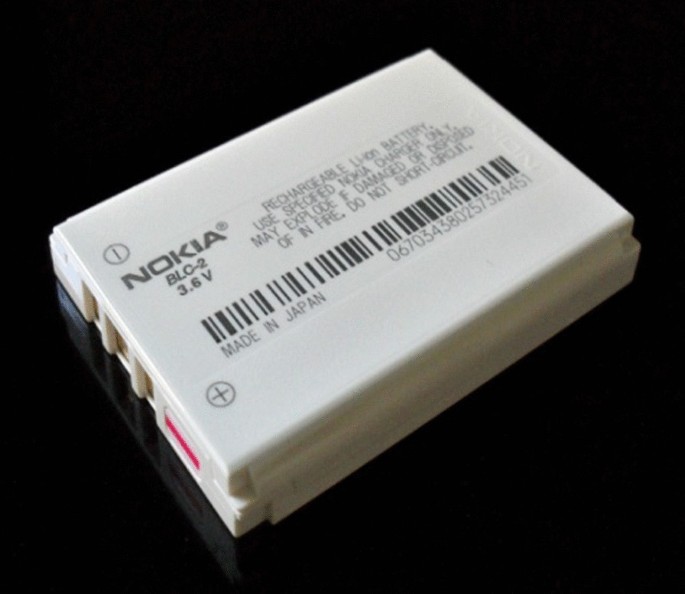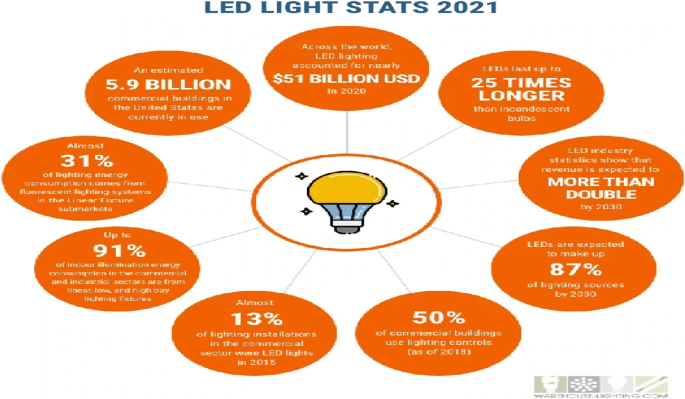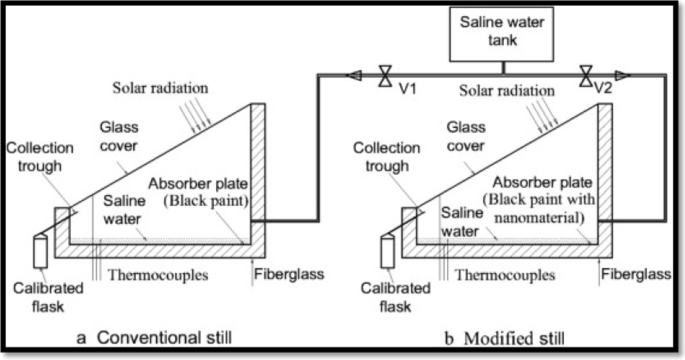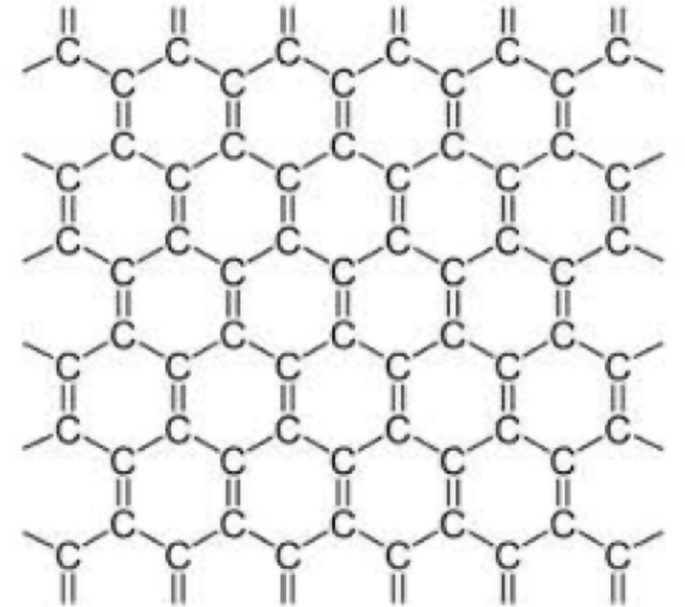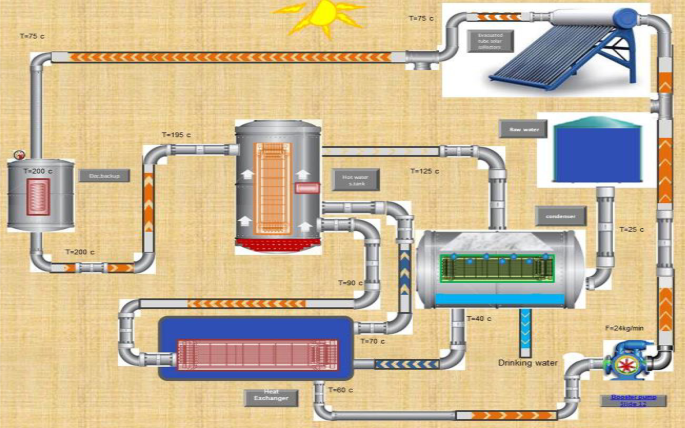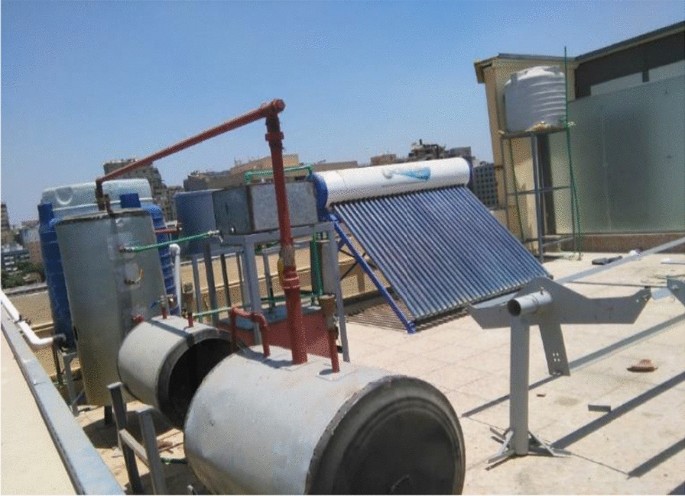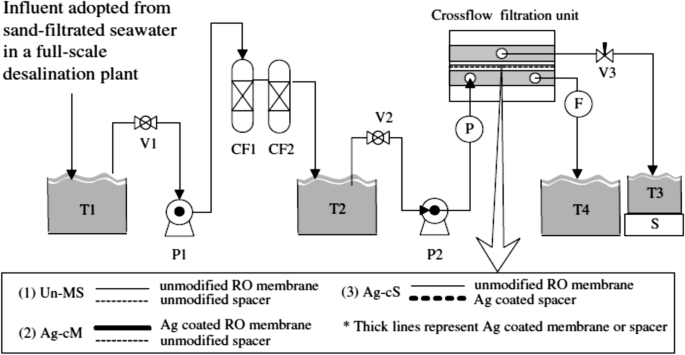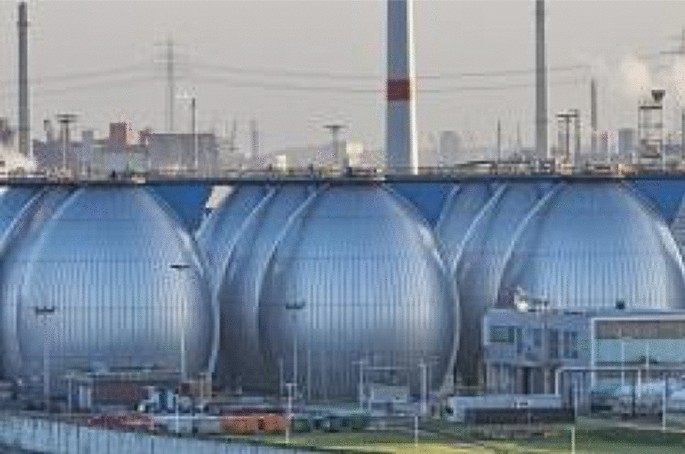- Review
- Open access
- Published:
The state of the art of nanomaterials and its applications in energy saving
Bulletin of the National Research Centre volume 47, Article number: 7 (2023)
Abstract
Background
Nanomaterials have emerged as a fascinating class of materials in high demand for a variety of practical applications. They are classified based on their composition, dimensions, or morphology. For the synthesis of nanomaterials, two approaches are used: top-down approaches and bottom-up approaches.
Main body of the abstract
Nanoscale materials and structures have the potential to be used in the production of newly developed devices with high efficiency, low cost, and low energy demand in a variety of applications. There are several contributions in renewable energy conversion and storage in the energy sector, such as solar photovoltaic systems, fuel cells, solar thermal systems, lithium-ion batteries, and lighting. Furthermore, nanofluid-based solar collectors are a new generation of solar collectors based on the use of nanotechnology. It has the potential to increase collector efficiency by up to 30%.
Short conclusion
Graphene and graphene derivatives are known as more efficient energy-saving materials, with the ability to maximize heat transfer efficiency and save up to 30% of energy in water desalination. Silver nanoparticles (Ag NPs) are a powerful antibacterial material that can kill a wide variety of microorganisms. They are commonly used in water treatment and are incorporated into polyethersulfone (PES) microfiltration membranes. The use of an Ag-PES membrane improved the antibiofouling performance of PES membranes. From the industrial application of nanotechnology, applications of TiO2-based nanocoatings that can be used as dust-repellent coatings for solar panels improve their efficiency and reduce the amount of required maintenance. Furthermore, the nanoscale dimension of these particles facilitates their movement in various body parts, resulting in serious diseases such as cancer and organ damage. As a result, it is suggested to focus in our incoming research on the disposal of nanomaterial waste and their safe application.
Background
Main text
Nanomaterials
Generally, any powdered materials with particle diameter ranged from 1 to 100 nm are categorized as nanosized materials (Manaktala and Singh 2016; Changseok et al. 2013). Accordingly, the nanomaterials have received much interest because of their high efficiency in many applications, such as smart coating devices (e.g., thermochromic, photochromic, and electrochromic devices), solar energy systems, and sensing. Also, they also improve efficiency and lower prices in a variety of fields, including solar photovoltaic systems, hydrogen production, and fuel cells. (Mageswari et al. 2016; Baig et al. 2021). Moreover, nanomaterials demonstrated unique chemical, physical, and biological properties that they can be applied in different fields.
Classification of nanomaterials
There are three types of nanomaterials based on their composition, including inorganic-, organic-, and carbon-based materials as shown in Table 1. Owing to unique size, nanomaterials exhibited higher reactivity, high sensitivity, large surface area, and strength.
Additionally, the nanoparticles can be categorized according to their dimensions (Jeevanandam et al. 2018; Buzea et al. 2016) exhibiting one or more dimensions within the nanoscale. The nanomaterials made from different materials demonstrate one nanoscale dimension such as surface coating attached on a substrate. By contrast, nanomaterials with two dimensions are usually nanoparticles applied on a substrate, nanoporous alumina wires or tubes, and nanoporous thin films. Three-dimensional nanomaterials can be exhibited a small nanostructure of a substrate or nanoporous membranes on a substrate. Nanomaterials can also be classified based on their morphology, such as nanocubes and nanowires. Finally, they can be graded according to their uniformity and agglomeration as represented in Fig. 1
Classification of nanostructured materials based on their morphology, dimensionality, composition, uniformity, and agglomeration state (Baig et al. 2021)
Synthesis of nanomaterials
As stated by Singh et al. 2020, top-down and bottom-up methods are the main approaches used for synthesizing nanomaterials (Fig. 2). For top-down strategy, coarse materials are disintegrated into nanostructured particles using laser ablation, mechanical milling, etching, electroexplosion, and sputtering. Meanwhile, bottom-up strategy includes spinning, vapor deposition, and sol–gel process.
The synthesis of nanomaterials via top-down and bottom-up approaches (Baig et al. 2021)
Top-down methods
Mechanical milling
This method is considered as a cost-efficient approach, in which the bulky materials transformed into nanosized ones. A blend of different nanophases as well as nanocomposites, such as copper-based nanoalloys and aluminum nickel magnesium, can be effectively prepared using this method (Sharma et al. 2021).
Electrospinning
It is regarded as one of the simplest top-down methods for synthesizing nano-based materials. This method is usually applied for synthesizing nanofiber-based polymers such as polyurethane nanofibrous membranes (Xiao et al. 2022).
Sputtering
Sputtering is a technique for producing nanoscale materials by blasting solid objects with high-energy particles delivered by plasma or gas. It is regarded as a viable technology for creating nanoscale thin film. Sputtering is a process in which intense gaseous ions bombard the target surface, causing the physical discharge of small-sized atom clusters based on the energy of the incident gaseous ion (Chodun et al. 2022).
Laser ablation
The process of laser ablation synthesis entails the formation of nanoparticles by shattering the target material with a powerful laser beam. In this method, high-energy laser irradiation caused a vaporization of the precursor or source material to yield nanosized materials. Owing to there is no need for chemical or stabilizing agent, laser ablation approach is categorized as a green method for synthesizing noble nanosized metals.
Bottom-up methods
Chemical vapor deposition (CVD)
The chemical vapor deposition approach was found to have a great importance in the formation of nanosized carbon-based materials, such as carbon nanotubes. The chemical reaction of vapor-phase materials produces a thin coating on the surfaces of substrate in CVD. The precursor should achieve the following requirements: high chemical purity, a nonhazardous nature, volatility, good stability during evaporation, a long shelf-life, and low cost. Furthermore, no residual impurities resulted from the decomposition process (Wang et al. 2022).
Hydrothermal methods
One of the most important and extensively utilized methods for producing nanosized materials is the hydrothermal process. In this method, nanoparticles synthesized though a heterogeneous reaction in a liquid medium at high temperature and pressure around the critical point in a sealed vessel. This approach exhibited different advantages over others. It can produce nanosized materials with no stability at high temperature. It can also generate nanosized materials with high vapor pressure with very low loss of starting materials. Hydrothermal method is beneficially used for synthesizing nanomaterials with different morphologies, such as such as nanorods, nanowires, nanosheets, and nanospheres (Gan et al. 2020).
The sol–gel method
The sol–gel method is a wet-chemical process for the creation of nanomaterials that has been widely employed. It was utilized to synthesize many types of nanomaterials-based metal oxide with high quality. The sol–gel method as eco-friendly approach exhibited many other advantages, including the production of nanomaterials with homogeneity, application of low processing temperature, and a facile way to produce complex nanostructures and composites (Khan et al. 2022).
Application of nanomaterials in energy sector
Energy has importance role in our daily life, and it is considered as the major resource for the human activity. According to the International Energy Agency (IEA), energy demand will continue to rise until 2030. Owing to increasing energy demand, there is a great need to new technology with low energy demand as a potential way to conserve energy. Lithium-ion batteries, light-emitting diode (LED), fuel cells, ultra-capacitor, and solar cell were used to conserve the energy as they improve the efficiency and application period. Nanotechnology is expected to contribute to low-cost and efficient energy generation, transmission, and storage systems in the future. The fabrication of materials and structures with nanoscale can potentially use for producing a newly developed devices with high efficiency, low cost, and low energy demand in many applications such as hydrogen production, solar photovoltaic systems, solar thermal systems, and energy saving technologies (Christian 2013; Yianoulis and Giannouli 2008). As a result, nanotechnology’s application in the field of energy is a hot topic in many scientific fields. The current trend is being hampered by the high cost of production compared to previous technologies. To obtain higher efficiency with low production cost, the priority should be given to nanotechnology in terms of energy. As shown in Fig. 3, piezoelectric, thermoelectric, triboelectric, catalytic, and photovoltaic are the main nanomaterials, which strongly contributed to several energy applications. Inorganic nanoparticles have superior thermal and electrical conductivity, chemical stability, and a wide surface area due to their unique properties. For the application of energy generation, nanosized materials recorded two-time thermoelectric performance higher than those of conventional materials.
Different energy applications: energy generation, storage, conversion, and saving up on nanomaterials substances (Wang et al. 2020)
As reported by International Energy Agency (IEA), the nanomaterials with high thermal insulation and energy efficiency will lead to conserve about 20% of the current energy consumption. There are three advantages, observed from the application of nanotechnology in the production of nanosized materials for renewable energy as follows:
-
An improvement in the efficiency of heating and lighting,
-
Higher capacity of electrical storage.
-
A significant reduction of the pollutants resulted from the use of conventional energy resources.
In energy conversion applications, the active sites of catalytic materials improved significantly by applying nanostructuring advanced strategy. The recent advances were found to have the potential to impel further the visions of alteration the hybrid properties at the nanoscale, which could lead to produce next generation materials for energy applications. Multifunctional nanomaterials research can be defined as the study on how the structures of materials govern their properties, including their fabrication and design (Wang et al. 2020).
Solar cell
Solar cell technology, as a valuable source of renewable energy, is nevertheless somewhat costly when compared to fossil fuels used to generate power. Although solar cells have a low efficiency, with a maximum of 30 percent, the most widely used kind has a 15–20 percent efficiency (http://www.i-sis.org.uk/QDA2011). Owing to losing more than a half of their efficiency through heat up, the conventional solar cells are inefficient. Recently, adding nanomaterials, such as fullerenes, carbon nanotubes (CNTs), and quantum dots, as shown in Figs. 4 and 5 to solar cell could increase its efficiency. Basically, nanotechnology technique can be beneficially used to build up high solar cells with high efficiency and low cost. Nanoparticles exhibited the following advantages in the solar power plants: -
-
1.
Because of the small particle sizes, nanomaterials can easily pass through pumps and plumbing with no adverse effects.
-
2.
Owing to high ability of nanofluids to absorb energy directly, they exceeded intermediate heat transfer steps.
-
3.
High optical selectivity of nanofluids (i.e., low emittance in the infrared range and high absorption in the solar range).
-
4.
Solar collector with nanomaterials exhibited more uniform receiver temperature, which associated with a reduction in material constraints.
-
5.
The enhancement of the heat transfer after incorporating nanoparticles, as a result of thermal conductivity and higher convection may improve receiver performance.
-
6.
The efficiency of absorption could be improved by tuning the nanoparticle shape and size to the appropriate application.
Zero-dimensional carbon nanomaterials, a carbon dots, and b fullerene. One-dimensional carbon nanomaterial, c carbon nanotube. Two-dimensional carbon nanomaterial, d graphene, and e graphene oxide (Han et al. 2015)
Evolution of photovoltaic technology: from conventional (silicon-based solar cells) to nanostructured solar cells (quantum-based and dye-sensitized solar cells) (Sharma et al. 2018; https://www.gamry.com/application-notes/physechem/dssc-dye-sensitized-solar-cells)
Quantum-based solar cell
As shown in Fig. 5, the addition of quantum dot crystals to the solar cell could improve the efficiency, whereas they possess high ability to absorb and convert light into electrical energy. This design is ideal for enhancing the solar cell efficacy from the small distance between the dots. Accordingly, multi release of electrons were gained via incorporation of quantum dots for solar cells. The efficiency of converting solar energy into electrical one increased by 42%.
Dye-sensitized solar cell (DSSC):
A dye-sensitized solar cells (DSSCs) are a class of low-cost solar cells belonging to the group of environmentally friendly thin-film solar cells. They have a good efficiency (nearly 20–30%) even under low flux of sunlight. The temperature sensitivity of the liquid electrolyte is considered as the main disadvantage of this type of solar cell. Many researches are carrying out to develop the electrolyte’s performance and consequently stability of solar cell. It is based on the photoelectrochemical processes. As shown in Fig. 6, the employing electrode is fabricated by depositing a thin layer of oxide semiconducting materials such as TiO2 (n-type) and NiO (p-type) on a transparent conductive glass plate made of indium tin oxide (ITO). These oxides have a wide band gap in the energy range from 3 to 3.2 eV. Because it is non-toxic, less expensive, and available, TiO2 is mostly used as a semiconducting layer. The dye is covalently attached to the surface of TiO2. Due to the high porosity structure and large surface area of the electrode, a large number of dye molecules are attached to the surface of the TiO2 nanoparticles, and thus, the light absorption on the surface of the semiconductor enhances. After laying an ultra-thin coating of TiO2 on the upper surface, the efficiency of about 18% was determined, it was shown that TiO2 was by 50% more efficient compared to the same material without coatings (Takabayashi et al. 2004), and they had synthesized a thin-film electrode made of a polycrystalline Si/doped TiO2 semiconductor. The system consists on a particulate doped TiO2 thin film supported on the surface on inexpensive polycrystalline Si, thus allowing to the absorption of short- and long-wavelength parts of the solar light, respectively. As a result, this combination can yield a high solar-to-chemical conversion efficiency of more than 10%, which results in a very promising approach to efficient and low-cost solar energy conversion.
Dye-sensitized solar cell (Serrano et al. 2009)
Consequently, TiO2 reduces directly the energy cost and yields cheaper solar cells.
Organic-polymer-based PV Solar cell (OPV):
In this type, particles are excited donating free electron–hole pairs via the effective field created between two dissimilar organic materials, known as the donor and accept or molecules. This type is obtained as an inexpensive renewable energy sources for the production of energy from light at very low cost (Pelemiš et al. 2013).
Hot carrier solar cells
In this cell, a free electron is highly bumped into the conduction band by a too-energetic photon. Therefore, its electronic temperature becomes quite hot (as high as 3000 K). The hot electron will relax to the bottom of the conduction band, typically through a few hundred femtoseconds, passing heat to the lattice. These cells have the advantages that a high-energy electron will enhance the photovoltage of the device that will result in increasing the cell efficiency. Finally, the advantages of solar cells are as follows:
-
Increasing device photovoltage as well as its efficiency due to using a high-energy electron.
-
Thin-film solar cells are the next generation of solar cells (flexible solar panels) that use less materials at low cost and are easier to produce and install.
For example, these sheets can be incorporated into a bag that charges laptop and cell phone. It can also cover buildings windows to collect solar energy from the entire building rather than just its roof (as shown in Fig. 7). So, it can be suitable to use as supply power to high-rise buildings.
-
Solve the problem of diffusion light absorption
PV system install on a Commercial Office Building (https://www.pointloadpower.com/articles/10-common-questions-commercial-building-owners-have-about-rooftop-solar)
Accordingly, Alamri et al. 2020 presented an investigation to improve the energy efficiency of solar PV panels using hydrophobic SiO2 nanomaterial. They concluded that the use of SiO2 coating for PV panels results in the better performance of the PV panels. The overall efficiency of the coated panel increased by 15% and 5%, compared to the dusty panel and the uncoated panel which was manually cleaned daily, respectively, that improve the overall efficiency and producing more efficient solar photovoltaic system.
Solar thermal collector
The solar collector is a key component of water heating systems and solar energy applications. It can be elucidated as a green heat exchanger device which converts the energy of incident solar radiation or sunlight either to electrical energy directly in PV (photovoltaic) applications, or to the thermal energy in solar thermal applications.
The performance of the solar collector is known as the ratio between the rates of useful heat (Q) transferred to a fluid and the solar radiation intensity falling on the collector surface. It was expressed previously as follows (Shaffei et al. 2021a, b):-
where η is collector efficiency, Q is the gained energy by water (W), Ac is the collector area (m2), and Gt is incident solar radiation W/m2
where η is collector efficiency, m mass of water, Cp = 4180 J/Kg oC, Ac area of collector, Gt W/m2intensity of incident light, Ti inlet temperature, and To outlet temperature.
To increase the collector efficiency, the researchers investigated several types of nanoblack coating to maximize the amount of solar energy absorbed by the black surface and converted into heat or electricity. In solar water heating systems, scientists studied different types of selective coatings such as black paint, sol-chrome, black chrome, black nickel, and black anodized aluminum to increase the collector efficiency and saving the energy consumption. However, some of these coating is high cost and also not friendly environmental such as chrome coating (Karuppiah et al. 2000). Moreover, the commercial black paint is strong emitters for thermal infrared radiation at high temperature which decrease the overall collector efficiency. Accordingly, Girginov et al. 2013 stated that electrodeposition of metal ions within porous alumina results in more efficient coating. The formed anodic aluminum oxide layer (AAO) is characterized by specific structure having self-organized and more-ordered nanopores as shown clearly in Fig. 8 (Shaffei et al. 2021a, b).
A Schematic of the ideal densely packed hexagonal array of pores; B Actual cross-sectional view of a typically synthesized AAO layer (Poinern et al. 2011)
Shaffei et al. (2021a, b) studied and tested the performance of two solar collector panels in two similar heating systems. The first system comprised the nanoblack-colored anodized aluminum solar panel and the other had black aluminum solar panel colored by commercial black paint for a comparison. The results confirmed that the nanoblack coating results in increment of the efficiency of solar heating system by approximately 12% compared with the commercial black paint.
Nanofluid-based solar collector
The nanofluid-based solar collector is a new generation of solar collectors based on nanotechnology (Hussein 2016), in which nanoparticles in a liquid medium scatter and absorb solar radiation.
The use of a nanofluid as a working fluid in the collector improves efficiency.
On top of the collector, a nanofluid absorbs the sun’s radiation directly.
As a result, this layer may eliminate the need for the absorber plate and tubes found in traditional solar collectors, as well as materials for both conventional and nanocollectors. The main difference between the conventional and nanofluid-based collectors lies in the mode of the working fluid heating. In the conventional collector, the sunlight is absorbed by a surface and then transmitted to the fluid (water or air), while in the nanofluid collector the sunlight is immediately absorbed by the working fluid through the radiative heat transfer as shown in Fig. 9.
Yousefi et al. 2012 studied the effect of utilizing the (Al2O3–water) nanofluid as an absorbing medium in a flat-plate solar collector. The nanoparticles weight fraction was taken as 0.2 and 0.4%, respectively. Moreover, the particles dimension was nearly 15 nm. The results showed that, on the addition of 0.2 wt% of nanofluid, the collector efficiency is increased by 28.3%. Consequently, the collector using an alumina–water nanofluid had higher efficiency than that using the water only. Regarding the data listed in Table 2, various types of nanofluids enhance the collector efficiency. The researchers concluded that nanoparticles increased heat-collection efficiency by up to 10 percent. (Taylor et al. 2011; www.sciencedaily.com/releases/2011/04/110405081910.htm).
Limitations of nanofluids in solar collectors
The benefits of using nanofluids in solar thermal collectors include increased thermal efficiency, potential reduction in collector size, and cost-effectiveness, while nanofluids are still limited in application in collectors as the nanofluids are highly unstable and their particles tend to precipitate. Meanwhile, the nanoparticles move in Brownian motion that results in aggregation and increases the fluid viscosity. As a result, increased viscosity reduces flow rate in thermosyphons or increases pump power required in forced convection systems. Both of these will eventually reduce the system’s efficiency (Wole‑osho et al. 2020).
Fuel cell
Nanostructured materials are being successfully used to increase the conversion of hydrogen energy into electricity via fuel cells. Fuel cell technologies have emerged as one of the most promising approaches to various energy resources, as well as to energy sustainability and the environment (Peterson et al. 2010). In a fuel cell, hydrogen and oxygen combine to form water, which produces electricity and heat. As illustrated in Fig. 10, this occurs in an environmentally beneficial manner, with no damaging carbon dioxide (CO2) emissions. Despite its many advantages, the fuel cell still has a number of disadvantages, including high cost, operability, and durability difficulties. Nanotechnology can be used to overcome these disadvantages. In practice, nanomaterials can be used in the fuel cell membrane (which is responsible for separating hydrogen into protons and electrons), the contribution of carbon nanotubes (CNTs) to improving the mechanical strength and proton conductivity of polymer electrolyte membranes, as well as catalysts and electrodes. Furthermore, storing huge amounts of hydrogen fuel is either too cumbersome or too expensive. Large amounts of hydrogen can be stored inside nanomaterials such as carbon nanotubes (CNTs) and carbon nanofibers, which is another key constraint in fuel cells. Carbon nanotube fuel cells, which are regarded the most environmentally acceptable form of energy, are currently being used to store hydrogen. Carbon nanotubes have a layered graphene tubular shape that allows them to store hydrogen efficiently. In reality, hydrogen can be adsorbed by carbon nanotubes (CNTs) by a physic-sorption phenomenon in which hydrogen is trapped in the cylindrical structure of the nanotubes or in the interstitial regions between nanotubes. Consequently, hydrogen has the best energy-to-weight ratio of any fuel and is widely utilized in space vehicles (Liu et al. 2010).
Hydrogen fuel cell (Bishop 2014)
Accordingly, the application of CNTs as the catalyst support in hydrogen production appears to be effective and attractive owing to their special structural morphology and characteristics. The surface of CNTs is usually modified to create the functional groups for specific needs. Nikitin et al. 2008 stated that the hydrogenation of single-walled carbon nanotubes (SWCNTs) using atomic hydrogen as the hydrogenation agent depends on the nanotube diameter, and for the diameter values around 2.0 nm. Hence, the hydrogenation (nanotube–hydrogen complexes) was close to 100% and is stable at room temperature. This results in enhancement of hydrogen storage capacity to 7 wt%. Girishkumar et al. 2005 investigated the power density of hydrogen cell based on using single-walled carbon nanotubes (SWCNTs) support and platinum catalyst. They concluded that the maximum power density of CFE/SWCNT/Pt electrodes was nearly 20% better than CFE/CB/Pt electrodes. Also, Orinakova and Orinak 2011 stated that the storage capacity of SWNTs and MWNTs for hydrogen is lower than 1 wt% at ambient temperature, but the capacity could be raised considerably between 4 and 8 wt% when decreasing the temperature of adsorption or modifying the CNTs. Some of the experimentally reported hydrogen storage capacities for different CNTs are summarized in Table 3. The variation in data of hydrogen storage capacity in CNT is based on their characteristics. The milled MWNTs at the same temperature and applied pressure result in increasing in hydrogen storage capacity; meanwhile, utilizing of milled MWNT may result in saving energy because there is no need for additional heating or higher pressure.
In addition, Amin et al. 2014 investigated the catalytic activity of impregnation of Ni and Pd/Ni nanoparticles on Vulcan XC-72R carbon black electrode for methanol oxidation in hydrogen cell. They tested the methanol oxidation reaction at Ni/C and Pd/Ni/C electrocatalysts in (0.2 M MeOH, 0.5 M KOH) solution and concluded that Pd/Ni/C is more stable than Pd/C and Ni/C electrocatalysts. Therefore, Pd/Ni/C is a suitable as a less expensive electrocatalyst for methanol oxidation that can be beneficially applied in fuel cells. Khater et al. 2022 studied the effect of bifunctional manganese oxide–silver nanocomposites anchored on graphitic mesoporous carbon to promote oxygen reduction and inhibit cathodic biofilm growth for long-term operation of microbial fuel cells, and they concluded that MnOx–Ag/GMC nanocomposites showed high antibacterial activity in MFCs, suppressing biofilm growth on the cathode. Consequently, MFCs with MnOx–Ag/GMC nanocomposites had a much higher maximum power density (160 mW m−2) compared to Pt/C.
Cathode-based MFCs (60 mW m−2) with a much lower closed-circuit potential decay during continuous operation for 5 months. Also Xie et al. 2022 presented highly efficient, economical, and environment friendly electrocatalysts for the hydrogen and oxygen evolution reactions that is necessary for economical water splitting. FeS2 nanoparticles were anchored on the surface of MXene through a simple adsorption-growth route (FeS2@MXene). The large active surface area of FeS2 and its robust interfacial interaction with conductive and hydrophilic MXene nanosheets and the obtained FeS2@MXene composite can accelerate the transfer of mass/charge and facilitate contact between water molecules and reactive sites of FeS2. They stated that the functioned hybrid bifunctional electrocatalyst requires only a cell voltage of 1.57 V to deliver a current density of 10 mA cm−2. The high catalytic activity of the FeS2@MXene hybrid is attributed to the well-designed structure and constructed interface between FeS2 and MXene, which results in a larger specific surface area, facilitated mass/charge transfer, and saving energy.
Lithium-Ion batteries
Nanostructured materials have recently been proposed for use in energy storage devices, particularly those with high charge/discharge current rates, such as lithium-ion batteries, which are widely used in mobile phones and laptops (as shown in Fig. 11).
A Li-ion battery from a Nokia mobile phone (https://en.wikipedia.org/wiki/Lithium-ion_battery)
Furthermore, the success of electric and hybrid electric vehicles (EVs and HEVs, respectively), which are predicted to at least partially replace conventional vehicles, is dependent on the development of energy storage devices with high power and high energy density. As a result, these energy storage solutions will rely on cutting-edge materials research, namely the development of electrode materials that can charge and discharge at high current rates. In general, nanostructure active electrode materials have the ability to increase the available power from a battery while reducing the time required to recharge it.
These advantages are obtained by coating the electrode’s surface with nanoparticles, which enhances the electrode’s surface area and allows more current to flow between the electrode and the chemicals within the battery. This technology could improve hybrid vehicle efficiency by lowering the weight of the batteries required to generate appropriate power. When the battery is not being used, nanomaterials are used to separate the liquids in the battery from the solid electrodes, extending the battery’s shelf life. This separation eliminates the low-level discharge that happens in a traditional battery, extending the battery’s shelf life significantly (https://www.understandingnano.com/batteries.htm).
The applications of nanotechnology in batteries are discussed as follows: -
-
Firstly, the modification of the active substance in the electrode material (cathode or anode) by adding nanomaterials.
-
Secondly, the application of nanotechnology to improve the performance of electrodes by using of nanocoatings. For example, nanodimensional additives such as nanocarbons, graphene, and carbon nanotubes have better electron conduction, or the use of nanothick coatings on the active material to prevent unwanted reactions with the electrolyte resulting the electrode stability and stress modulation. Regarding LiFePO4 cathode, the amount of electron conductivity is poor. Hence, the conductivity is enhanced by using a conductive carbon coating on its particles or applying a conductive carbon material as an additive. Also, LiCoO2 cathode is unstable at high currents in the vicinity of the electrolyte; for stabilization, nanothick oxide coating can be utilized. Accordingly, carbon coating increases conductivity, capacity, and consequently the cell power. However, the research in this area (to create this coating) is still insufficient. Therefore, research in the field of synthesis methods is very important (Songping et al. 2015).
Lighting
The creation and usage of energy efficient LEDs based on inorganic and organic semiconductor materials was the first nanotechnology application in the field of lighting. LED technology has already tapped huge commercial potentials in the illumination of displays, buildings, and cars due to its compact form, flexible color scheme, and high energy yield. It was created with the purpose of enhancing the energy efficiency of LEDs by using quantum dots. Furthermore, nanoscale light-emitting particles aid in the reduction of LED scattering effects, resulting in an increase in light production. To boost particle stability, the particles must be coated (Hessian 2008).
As shown in Fig. 12, LEDs are predicted to account for 87% of lighting sources by 2030, with lighting controls accounting for 50% of lighting installations in commercial buildings. In 2015, about 13% of lighting installations in the commercial sector were LED lights. Up to 91% of indoor illumination energy usage occurs in the commercial and industrial sectors.
Lead lighting share in industry (https://www.warehouse-lighting.com/blogs/lighting-blog/led-lighting-statistics)
The high efficient nanomaterials in energy saving
Graphene
Graphene is one of nanomaterials having high electrical conductivity and excellent mechanical strength. It is a super-capacitive biodegradable material that is less expensive than pure silicon. Furthermore, graphene can absorb solar energy’s ultraviolet radiation, which is ignored by Si solar cells. As a result, solar cells with a wavelength of 0.345 nm can absorb more solar light. Das et al. 2017 investigated the melting of carbon-based nanocomposites in a vertically oriented shell-tube thermal energy storage system. They looked at the effect of carbonic nanomaterial structure on the thermal behavior of n-eicosane (phase change materials (PCM): as nanofillers to improve n-alkane thermal conductivity). They investigated the effects of three structures on melting time: single-walled carbon nanotubes (SWCNT), nanodiamond, and graphene nanoplatelets. Their research found that using nanodiamond had no effect on melting time when SWCNT and graphene were used at a 1% by volume ratio. It was discovered that melting duration could be reduced by up to 15% and 25%, respectively. The improved thermal conductivity caused by the nanostructures incorporation was attributed to the shorter melting time. In addition, Hussein et al. 2021 investigated the effect of nanographene dispersion on the rate of evaporation of saline water to save energy consumption during thermal desalination and concluded that graphene is one of the best nanomaterials for maximizing heat transfer efficiency because it maximized the broken hydrogen bond between water molecules and minimized the viscosity of saline water, resulting in maximum energy savings by 30% on using 10 g/l.
The energy-saving efficiency declined as the graphene increased. Meanwhile, even though graphene breaks the hydrogen bond, the increase in saline viscosity lowers the boiling point. As a result, there is a critical dose that maximizes hydrogen bond breaking while lowering saline water viscosity. The optimum dose was determined to be 10 g of nanographene/1 L of saline water based on these findings (Hussein et al. 2021). Furthermore, Hussein et al. 2020 investigated the use of nanographene oxide in the thermal desalination of saline water. The generated desalinated water quantity acquired utilizing nanographene oxide was more than double that obtained using the usual thermal desalination process, resulting in a 22% energy savings.
Quantum dots
The quantum dots are mainly semiconductor crystals with nanoscale, which possess high ability to absorb and convert light into electrical energy. Owing to their small size, dots can spray onto flexible surfaces like plastic. This design is ideal for enhancing the efficacy of the small distance between the dots. The efficiency of converting solar energy into electrical one increased on applying quantum dots (Sabr et al. 2022). Because of its superior properties, such as thermal conductivity, metallic or semiconducting electronic behavior, and surface area, CNTs strongly contributed to the enhancement of conversion of solar energy into electricity or the generation of fuels through photocatalysis (Sharma et al. 2018). Experiments have already shown that quantum dots (tiny nanoparticles only a few nanometers in size) are three times more efficient at converting solar energy than the best material currently used in solar cells.
Nanosilver
The application of nanomaterials in water and wastewater treatment has grown wide attention. Nanomaterials have high reactivity and adsorption capacities due to their unique characteristics, small diameters, and large specific surface areas. Antibacterial silver nanoparticles (Ag NPs) are effective against a variety of microorganisms, including viruses, bacteria, and fungi (Borrego et al. 2016). As a result, Ag NP is an effective antimicrobial agent that is widely used in water decontamination (Kalhapure et al. 2015). Because of their high antibacterial activity and cost-effectiveness, these nanoparticles (Ag NPs) adhered to the filter materials in the water disinfection process. Chemical reduction is also used to make Ag NPs, which are then integrated into polyethersulfone (PES) microfiltration membranes.
These PES-Ag NPs membranes have excellent antibacterial properties and are widely used in water treatment. For disinfection and biofouling reduction in domestic water treatment, Ag NPs are also integrated into ceramic materials/membranes. It is possible to improve the removal effectiveness of Escherichia coli by adding Ag NPs to ceramic filters made of clay and sawdust. Furthermore, it was discovered that filters with a higher porosity removed more germs than those with a lower porosity (Krishnaraj et al 2012). Furthermore, colloidal Ag NPs have been coupled with clay-rich soil-based cylindrical ceramic filters. Colloidal Ag NPs increased filter performance, and the filters can remove Escherichia coli at a rate of between 97.8 and 100% (Lu et al. 2016; Oyanedel-Craver and Smith 2008). Several types of nanomaterials applications for water and wastewater treatment are listed in Table 4.
Nanomaterial on the solar still productivity
Solar still distillation is one of the most primitive types of water treatment that contributes to the solution of the water crisis. Solar stills, as generally known, have numerous advantages, including being simple, inexpensive, pollution-free, and requiring less maintenance. However, the freshwater yield of a conventional solar still (CSS) is restricted. As a result, researchers are attempting to improve its efficiency by employing a variety of nanomaterials. The performance of a modified solar still (MSS) can be improved by adding copper oxide nanoparticles to the black paint, for example. As the concentration of nanoparticles increases, the water productivity enhanced. Meanwhile, raising the concentration of nanomaterials increases the rate of heat transmission between the basin water and the still walls. Furthermore, as compared to CSS, using CuO nanoparticles boosts freshwater productivity by around 16% and 25% at weight fraction concentrations of 10% and 40%, respectively, as shown in Fig. 13 (Kabeel et al. 2017).
Layout diagram of conventional solar still and modified solar still with nanoparticles (Kabeel et al. 2017)
Industrial application of nanomaterials
Nanotechnology was applied in many industrial activities and private sectors through the optimization of products for substantially maintaining the energy consumption.
Dust-repellent coatings with TiO2-based nanomolecules
The conventional applications of nano-TiO2-modified coatings can be effectively used to control the dirt and dust after exposure of an area to ultraviolet radiation. The system of nanoparticle delivery was developed by a new company (Swift Coat), which can be beneficially used to synthesize coatings with high efficiency in dust repellent for solar panels with less needed maintenance. It is expected that the application of such nanoparticle delivery can be successfully used in preventing solar panels soiling. The accumulation of debris, dust, and dirt on the surface’s panel with increasing time can decrease its efficiency. With more exposure time to these pollutants, the efficiency of solar cells decreases by 30%. This can result in serious problems for consumers and businesses. The installed solar panels on home’s roof could not be easily reachable by a homeowner. A continues loss in the efficiency of panels for months occurs if the homeowners cannot continuously be cleaning the panels. Similar challenges can be faced by businesses with remote solar installations. The costs of labors who clean solar panels can negatively affect. The labor’s costs for cleaning solar panels can significantly cut into the savings the company may have safeguarded by adopting a source of green energy (Newton 2021).
Corrosion protection
Corrosion is regarded as an important issue in the industrial world. Globally, the expected annual cost of preventing corrosion, including checking and substituting parts and shielding against corrosion—is around $2.5 trillion. Based on National Association of Corrosion Engineers (NACE), this value is equivalent to 3.4% of the global gross domestic product (GDP) in 2020. As well known, the application of industrial paints and coatings on panels act as a protected layer against corrosion. Moreover, the life span of metal parts can be extended by after coating it. Alternatives that are highly effective in resisting corrosion have been developed using nanotechnology. The use of nanotechnology has resulted in corrosion-resistant alternatives.
Paints and coatings
Graphene’s anticorrosive properties have been discovered by recent study conducted by South Australian chemicals company Technology using commercially available coatings and paints. Figure 14 shows the lattice-like structure of graphene, which is made up of carbon atoms arranged in a thin sheet. Scientists exposed steel surfaces to 1344 h of salt spray to test the power of the graphene coating and a control coating. The company claims that scribe creep improved sixfold when graphene was added to the control coatings, suggesting improved corrosion resistance. These paints and coatings were applied to smooth, cold-rolled steel as part of the company’s tests. Steel is considered to be a challenging substrate for anticorrosive coatings. Coatings tend to adhere to abrasive blast-cleaned steel more readily due to its more suitable anchor profile compared with similar substrates. Graphene coatings proved very successful for the research team, combining with other corrosion management techniques like temperature control and improved air flow to make valuable assets for industrial applications.
Structure of graphene (https://www.graphene-info.com/graphene-structure-and-shape)
Risk of Nanomaterials
Nanoparticles can get up in the environment by mistake or as a result of their synthesis, transportation, storage, usage, or disposal. The nanoscale diameter of these particles facilitates their migration in numerous bodily areas, which can result in catastrophic illnesses such as cancer and organ damage. Furthermore, nanoparticles inhaled by an organism can easily reach the heart, liver, and blood cells via the circulation. As a result, further study is needed to close the knowledge and information gap concerning nanoparticle behavior in soil, air, and water, as well as their accumulative qualities in food chains. Because nanotechnology is still in its infancy, there are concerns regarding the impact of its industrial and commercial applications on the environment and organisms (Pandey and Jain 2020). Table 5 lists the overall features as well as the danger of nanoparticles.
Cost of nanomaterials
On applying nanotechnology-based treatments, distinct contributions from the purchase or synthesis of nanomaterials, energy (such as electricity necessary for photocatalysis treatments using nanoparticles, for example), and labor should all be taken into account when estimating operational costs (Kamali et al. 2019). Nanomaterial prices are largely dependent on the material type and desired features such as purity level (wt%), surface functionalization, and particle size. Prices for TiO2 nanoparticles range from $0.03 per gram to $1.21 per gram, with treatment expenses ranging from $0.50 to $1.00 per gram of pollution. The cost of nanozero-valent iron (nZVI) particles has fallen as the technology for their manufacture has improved, and they are now roughly $0.05–0.10/g. In terms of manufacturing, however, micro- and bulk zero-valent iron are still significantly less expensive ($0.001/g) (Crane and Scott 2012). The cost of magnetite nanoparticles was predicted to be around 0.0035 €/g, according to (Simeonidis et al. 2015). CuO on -Al2O3 is also the most cost-effective material, with an estimated treatment cost of 0.07 $ per gram of metal for an 80 percent pollution load reduction. Application of visible-light active nanoparticles such as N-TiO2 or solar energy consumption is recommended as ideal alternative in locations where power prices are high (Yoshida et al. 2014).
Case studies
Case study (1) Performance Improvement of Solar Water.
Distillation System Using Nano fluid Particles (El-Ghetany et al. 2021).
Location The experimental pilot unit was installed in Solar Energy.
Department, National Research Centre, and Giza, Egypt.
Capacity up to 6000 L /day.
Process The technology is designed to produce freshwater.
As indicated in Fig. 15, solar energy was used in the desalination process to gain freshwater. The water desalination system is divided into two loops: the heat transfer fluid (HTF) loop and the water loop. To transport thermal energy from the heat pipe evacuated tube collector to the thermal oil storage tank, synthetic thermal heating oil was chosen as the heat transfer fluid. It offers high resistance to thermal cracking, high heat transfer efficiency, and proper properties of heat transfer, low maintenance costs, and a long life (Fig. 16).
Photographic view of a solar water desalination system using evacuated tube collector (El-Ghetany et al. 2021)
The HTF loop is made up of four parts: an evacuated tube collector with a storage tank, a hot oil stainless steel coil immersed in a thermal storage tank of hot water that acts as a heat exchanger, a backup electric heater for auxiliary heating, and a hot oil circulation pump. After passing through the backup electric heater, the HTF is heated in the solar evacuated tube collector and the obtained thermal energy is transported to the 100 L hot water storage tank. The temperature of the pumped HTF is increased in the evacuated tube collector to between 75 and 90 degrees Celsius, and then, it is heated to 200 degrees Celsius in the hot oil auxiliary heater. On a solar water distillation system, the influence of nanoparticle concentrations of TiO2 combined with hot oil loop was investigated to evaluate the daily water productivity with varied concentrations of TiO2.
Results Applying nanofluid particles (TiO2) to the heat transfer fluid of the solar water distillation system improves heat transfer properties and hence boosts daily water productivity. When utilizing 100 mg/l TiO2 nanoparticle concentration, the given system may produce 5616 L per day in the reference unit (without nanoparticle), and 7128 L per day in the case of using 100 mg/l TiO2 nanoparticle concentration. The use of TiO2 nanoparticles at a concentration of 100 mg/l resulted in a 26.9% increase in daily distilled water productivity. This boost in performance will improve the use of nanofluids in heat transfer loops, resulting in a higher daily rate of productivity.
Case study (2) Nanosilver-enabled composite for water treatment (Adonizio et al. 2019).
Location Solar energy-powered water treatment technology, developed by Quest Water Solutions Inc. (Canada).
Capacity up to 20,000 L per day.
Process A nano-enabled composite is included in a point-of-use (POU) water purification system with a two-stage filtering process that produces 10 L of clean water in 1 h; on the other hand, the second stage absorbs chemical contaminants.
The first stage It had an antibacterial unit that was in charge of eliminating viruses and germs. Nanocrystalline aluminum oxyhydroxide–chitosan composite embedded with 10–20 nm silver nanoparticles makes up the unit. Over a long length of time, the device may constantly emit regulated quantities of silver ions (40 ± 10 ppb) into natural drinking water. The antibacterial composite was created using a green synthesis approach that can be used at room temperature and does not require electricity to function.
The second stage It uses an activated carbon black filter with a nominal pore size of 4 m to filter out cysts and adsorb the organic pollutants, bacterial biomass, metals, pesticides, and other contaminants.
Results For a household of five, a cartridge containing 120 g of the nanosilver-based antimicrobial compound may supply safe drinking water for one year (assuming daily drinking water consumption of 10 L). This equates to a $2 yearly cost per household, which includes cartridge packing, media, plastic assembly, and sediment pre-filter. The unit may be readily activated by submerging it in water (natural drinking water) for 3–4 h at 70–100 degrees Celsius, which reduces the cost and increases the device’s durability.
Case study (3) Surface modification of RO membrane and spacer of Seawater desalination pilot set-up in Wukan desalination plant (Yang et al. 2009):
Location Pilot plant in the Wukan desalination plant at Penghu, which is one of Taiwan’s main off-shore islands.
Feed Actual sea water pretreated by cross-media sand filter and 5-mm cartridge filter.
Process The pilot plant setup was simulated to the actual process of the full-scale desalination plant. The influent was collected from the full-scale desalination plant’s sand filter unit and feed water tank storage, as indicated in Fig. 17. The seawater was injected to pass through two (in-series 5-mm cartridge) filters then flow into a buffer tank. Then, using a high-pressure pump, RO feed was continuously pushed into one commercial flat-sheet membrane filtering machine, with feed flow rates set at 2 L/min. Throughout the testing, the system was operated in a constant pressure mode with a set pressure of 55.2 bar.
Schematics of seawater desalination pilot plant and cross-flow RO membrane cell for biofouling test (T1: feed water tank; T2: RO feed tank; T3: permeate tank; T4: concentrate tank; CF1, CF2: 5-mm cartridge filter; P1: pump; P2: high-pressure pump; P: pressure meter; F: flow rate meter; S: scale; V1, V2: ball valve; and V3: pressure release valve)
Surface modification of RO membrane and spacer
A simple nanosilver-coating process was used as a surface modification solution to minimize membrane biofouling on site in this case study. All of the flat-sheet RO membranes came from a spiral-wound membrane module (SW30-2514, FILMTECDOW), which is the same membrane that was utilized in the full-scale desalination plant. To enhance silver ion adsorption on the membrane sheet, it was first soaked in silver nitrate solution for thirty minutes. The membrane was then immersed in formaldehyde solution for forty minutes to initiate the reduction process. The same method was used to coat the spacer, which was separated from the same spiral-bound module.
Results In terms of permeate flow and TDS rejection, both the silver-coated membrane with uncoated spacer and the silver-coated spacer with uncoated membrane excelled the unmodified membrane and spacer. The antibacterial action of the silver-coated spacer, on the other hand, lasted longer. During the whole testing time of the silver-coated spacer test, there was essentially no cell reproduction on the membrane. Furthermore, the cells that adhered to the membrane appeared to lose activity soon. Hence, the modified membrane saving the total cost required for replacing by another units and labor cost for cleaning the unit.
Case study (4) NANOTECHNOLOGY FOR WATER TREATMENT.
Location The desalination plant in Llobregat, Barcelona, Spain (Fig. 18).
A picture of the desalination plant in Barcelona (Adeleye et al. 2019)
Capacity The largest reverse osmosis-based desalination plant in Europe with an output of 200,000 cubic meters per day (Adeleye et al. 2019).
Process They were able to build membranes that resist biofouling better than any other membranes before because they used nanoparticles in their membrane coating. Nanotechnology was employed by nano-H2O to improve the permeability of their desalination membranes. They were able to develop a membrane with improved permeability of 50–100% by incorporating zeolite particles into the polyamide rejection layer.
Results Spain has adopted the NAWADES project. TFN membranes from nano-H2O have already been installed in Los Angeles, China, with ambitions to extend to the Middle East. Carbon nanotubes have offered a new way for water desalination, in addition to these approaches. The previous reverse osmosis processes will be replaced by these new technologies. Desalination plant efficiency will improve, resulting in the production of more clean, drinkable water. Finally, advancements in desalination technology can only contribute to the system’s long-term survival.
Conclusions
Nanotechnology has a significant impact on human life because it provides cheap and clean energy. As a result, it provides a significant evolution in several renewable energy devices used for energy storage and conversion, as well as environmentally beneficial materials. It has been demonstrated that they improve efficiencies and lower costs in a several areas. Nanomaterials promote solar photovoltaic systems, lithium-ion batteries, and fuel cells that lead to conserve about 20% of the current energy consumption. Moreover, nanomaterials demonstrated unique chemical, physical, and biological properties. Considerable energy saving potentials through the optimized products and production plants are found in nearly all branches of industry via nanotechnology. Nanofluids, nanographene, nanosilver, TiO2, CuO, Al2O3, and nanocomposites are potentially applied in industrial field. Nanoparticles emitted into the environment cause catastrophic illnesses such as cancer and organ damage. Furthermore, nanoparticles inhaled by an organism can easily reach the heart, liver, and blood cells via the circulation. As a result, the disposal of solid nanomaterial waste must be researched in order to maintain a clean and safe environment.
Availability of data and materials
The datasets used and/or analyzed during the current study are available from the corresponding author on reasonable request.
Abbreviations
- Ag NPs:
-
Silver nanoparticles
- PES:
-
Polyethersulfone
- CNTs:
-
Carbon nanotubes
- CVD:
-
Chemical vapor deposition
- IEA:
-
International Energy Agency
- LED:
-
Light-emitting diode
- DSSC:
-
Dye-sensitized solar cell
- ITO:
-
Indium tin oxide
- OPV:
-
Organic-polymer-based PV solar cell
- PV:
-
Photovoltaic
- AAO:
-
Anodic aluminum oxide
- CO2 :
-
Carbon dioxide
- EVs:
-
Electric vehicles
- HEVs:
-
Hybrid electric vehicles
- PCM:
-
Phase change materials
- SWCNT:
-
Single-walled carbon nanotubes
- RO:
-
Reverse osmosis membranes
- NREL:
-
National Renewable Energy Laboratory
- CSS:
-
Conventional solar still
- MSS:
-
Modified solar still
- GDP:
-
Global gross domestic product
- NACE:
-
National Association of Corrosion Engineers
- POU:
-
Point of use
- Ppb:
-
Part per billion
- HTF:
-
Heat transfer fluid
References
Adeleye AS, Conway JR, Garner K, Huang Y, Su Y, Keller AA (2016) Engineered nanomaterials for water treatment and remediation: costs, benefits, and applicability. Chem Eng J 286:640–662
Adeleye SA, Conway JR, Garner K, Huang Y, Su Y, Keller AA (2019) Engineered nanomaterials for water treatment and remediation: Costs, benefits, and applicability. Tongji University, State Key Laboratory of Pollution Control and Resources Reuse
Adonizio J, Hess B, Metz S (2019) Nanotechnology for water treatment, University of Pittsburgh, Swanson School of Engineering First-Year Conference Paper
Alamri HR, Rezk H, Abd-Elbary H, Ziedan HA, Elnozahy A (2020) Experimental investigation to improve the energy efficiency of solar PV panels using hydrophobic SiO2 nanomaterial. Coatings 10:503
American Institute of Physics. "Nanoparticles improve solar collection efficiency. (2011) www.sciencedaily.com/releases/2011/04/110405081910.htm
Amin RS, Abdel Hameed RM, El-Khatib KM, Elsayed Youssef M (2014) Electrocatalytic activity of nanostructured Ni and PdeNi on Vulcan XC-72R carbon black for methanol oxidation in alkaline medium. Int J Hydrogen Energy 39:2026–2041
Baig N, Kammakakam I, Falath W (2021) Nanomaterials: a review of synthesis methods, properties, recent progress, and challenges. Mater Adv 2:1821–1871
Bishop C (2014) Nanotechnology and its applications to fuel cells. University of Tulsa, Power Point Lecture
Borrego B, Lorenzo G, Mota-Morales JD et al (2016) Potential application of silver nanoparticles to control the infectivity of Rift Valley fever virus in vitro and in vivo. Nanomed Nanotechnol Biol Med 12:1185–1192
Buzea C, Pacheco I (2016) Nanomaterials and their classification. EMR/ESR/EPR Spectrosc Char Nanomater 3–45
Changseok H et al (2013) Chapter green nanotechnology: development of nanomaterials for environmental and energy applications. Am Chem Soc 201–229.
Cheng J, Yuan X, Zhao L, Huang D, Zhao M, Dai L et al (2004) GCMC simulation of hydrogen physisorption on carbon nanotubes and nanotube arrays. Carbon 42:2019–2024
Chodun R, Dypa M, Wicher B, Nowakowska K, Okrasa LS, Minikayev R, Zdunek K (2022) The sputtering of titanium magnetron target with increased temperature in reactive atmosphere by gas injection magnetron sputtering technique. Appl Surf Sci 574:151597
Christian F (2013) Application of nanotechnologies in the energy sector: a brief and short review. Front Energy 7(1):6–18
Crane RA, Scott TB (2012) Nanoscale zero-valent iron: future prospects for an emerging water treatment technology. J Hazard Mater 211–212:112–125
Das N, Takata Y, Kohno M, Harish S (2017) Effect of carbon nano inclusion dimensionality on the melting of phase change nanocomposites in vertical shell-tube thermal energy storage unit. Int J Heat Mass Transf 113:423–431
El-Ghetany HH, Elgohary HM, Mohammed YM (2021) Performance improvement of solar water distillation system using nanofluid particles. Egypt J Chem 64:44254431
Eltaweel M, Abdel-Rehim AA (2019) Energy and exergy analysis of a thermosiphon and forced-circulation flat-plate solar collector using MWCNT/Water nanofluid. Case Stud Therm Eng 14:100416
Ervonen T, Linkov I, Figueira JR, Steevens J, Chappell M, Merad M (2009) Risk-based classification system of nanomaterials. J Nanopart Res 11:757
Faizal M, Saidur R, Mekhilef S, Hepbasli A, Mahbubul IM (2015) Energy, economic, and environmental analysis of a flat-plate solar collector operated with SiO2 nanofluid. Clean Technol Environ Policy 17:1457–1473
Gan XY, Jayatissa AH, Yu Z, Chen X, Li M (2020) Hydrothermal synthesis of nanomaterials. J Nanomater 3
Girginov ChA, Kanazirski IA, GIlcheva V, (2013) Electrolytic coloring of porous aluminum oxide films in CoSO4 Solution, Bulgarian. Chem Commun Spec Ed A 45:52–56
Girishkumar G, Rettker M, Underhile R, Binz D, VinodgopalK MP, Kamat P (2005) Single-wall carbon nanotube-based proton exchange membrane assembly for hydrogen fuel cells. Langmuir 21(18):8487–8494
Habuda-Stanić M, Nujić M (2015) Arsenic removal by nanoparticles: a review. Environ Sci Pollut Res 22:8094–8123
Han X, Li S, Peng Z, Al-Yuobi AO et al (2015) Interactions between carbon nanomaterials and biomolecules. J Oleo Sci 65(1):1–7
He Q, Zeng S, Wang S (2014) Experimental investigation on the efficiency of flat-plate solar collectors with nanofluids. Appl Therm Eng 88:165–171
He X, Deng H, Hwang H-m (2019) The current application of nanotechnology in food and agriculture. J Food Drug Anal 27(1):1–21
Hessian AR (2008) Ministry of Economy, Transport, Urban and Regional Development, www.hessen-nanotech.de, Application of Nanotechnologies in the Energy Sector. Vol. 9 Nanotech.. https://www.warehouse-lighting.com/blogs/lighting-blog/led-lighting-statistics
Hussein AK (2016) Applications of nanotechnology to improve the performance of solar collectors: recent advances and overview. Renew Sustain Energy Rev 62:767–792
Hussein HS, Shaarawy HH, Hussien Nabila H, Abdelkader E, Hawash SI (2020) Potential application of nano graphene oxide for saving energy in water thermal desalination system part I. SN Appl Sci 2:1102
Hussein HS, Shaarawy HH, Hussien Nabila H, Abdelkader E, Hawash SI (2021) Synthesis of nano graphene for saving energy in water desalination. J Clean Eng Technol 4:100162
Institute of Science in Society (ISIS) Quantum dots and ultra-efficient solar cells (2011) http://www.i-sis.org.uk/QDA
Jeevanandam J, Barhoum A, Chan Yen S, Dufresne A, Danquah MK (2018) Review on nanoparticles and nanostructured materials: history, sources, toxicity and regulations. J Nanotechnol 9:1050–1074
Johnson VR (2016) Nanotechnology, environmental risks, and regulatoryoptions. Penn St L Rev 121:471–503
Justo-Hanani R, Dayan T (2015) European risk governance of nanotechnology: explaining the emerging regulatory policy. Res Policy 44(8):1527–1536
Kabeel AE, Omara ZM, Essa FA, Abdullah AS et al (2017) Augmentation of a solar still distillate yield via absorber plate coated with black nanoparticles. Alex Eng J 56:433–438
Kalhapure RS, Sonawane SJ, Sikwal DR et al (2015) Solid lipid nanoparticles of Clotrimazole silver complex: an efficient nano antibacterial against Staphylococcus aureus and MRSA. Colloids Surf B 136:651–658
Kamali M, Persson MEC, Capela I (2019) Sustainability criteria for assessing nanotechnology applicability in industrial wastewater treatment: current status and future outlook. Environ Int 125:261–276
Karuppiah N, John S (2000) Characterization of electrodeposited nichel-cobalt based selective coatings for solar thermal energy conversion. N Bull Electrochem 16(2):71–74
Kennedy AJ, Hull MS, Steevens JA, Dontsova KM, Chappell MA, Gunter JC, Weiss CA (2008) Factors influencing the partitioning and toxicity of nanotubes in the aquatic environment. Environ Toxicol Chem 27:1932–1941
Khan SA, Zahera M, Khan IA, Khan MS, Azam A (2022) Photocatalytic degradation of methyl orange by cadmium oxide nanoparticles synthesized by the sol-gel method. Optik 251:168401
Khater DZ, Amin RS, Fetohi AE, El-Khatib KM, Mahmoud M (2022) Bifunctional manganese oxide–silver nanocomposites anchored on graphitic mesoporous carbon to promote oxygen reduction and inhibit cathodic biofilm growth for long-term operation of microbial fuel cells fed with sewage. Sustain Energy Fuels 6:430–439
Krishnaraj C, Ramachandran R, Mohan K, Kalaichelvan PT (2012) Optimization for rapid synthesis of silver nanoparticles and its effect on phytopathogenic fungi. Spectrochimica Acta Part A Mol Biomol Spectrosc 93:95–99
Kyzas GZ, Bikiaris DN (2015) Recent modifications of chitosan for adsorption applications: a critical and systematic review. Mar Drugs 13:312–337
Liu C, Burghaus U, Besenbacher F, Wang Z (2010) Preparation and characterization of nanomaterials for sustainable energy production. Nano Focus 4:5517–5526
Lu H, Wang J, Stoller M, Wang T, Bao Y, Hao H (2016) An overview of nanomaterials for water and wastewater treatment. Adv Mater Sci Eng:10
Mageswari A, Srinivasan R, Subramanian P (2016) Nanomaterials: classification, biological synthesis and characterization. Nanosci Food Agric 3:31–71
Manaktala SS, Singh KM (2016) Nanotechnology for energy applications. ISST J Electr Electron Eng 7:63–69
Morales-Díaz AB, Ortega-Ortíz H, Juárez-Maldonado A, Cadenas-Pliego G, GonzálezMorales S, Adalberto B-MA (2017) Application of nanoelements in plant nutrition and its impact in ecosystems. Adv Nat Sci Nanosci Nanotechnol 8:1–13
Newton E, Three Trending Applications for Nanoparticles in Paints (2021) https://www.graphene-info.com/graphene-structure-and-shape
Nikitin A, Li X, Zhang Z, Ogasawara H, Dai H, Nilsson A (2008) Hydrogen storage in carbon nanotubes through the formation of stable C-H bonds. Nano Lett 8:162–167
Orinakova R, Orinak A (2011) Recent applications of carbon nanotubes in hydrogen production and storage. Fuel 90:3123–3140
Oyanedel-Craver VA, Smith JA (2008) Sustainable colloidal silver-impregnated ceramic filter for point-of-use water treatment. Environ Sci Technol 42:927–933
Pandey G, Jain P (2020) Assessing the nanotechnology on the grounds of costs, benefits, and risks. J Basic Appl Sci 9:63
Pelemiš S, Hut I (2013) Nanotechnology materials for solar energy conversion. Contemp Mater (renew Energy Sour) 2:145–151
Peterson G, Li C, Wang M, Chen G (2010) Micro/nano transport phenomena in renewable energy and energy efficiency. Adv Mech Eng 1–2
Poinern G, Ali N, Fawcett D (2011) Progress in nano-engineered anodic aluminum oxide membrane development. Materials 4:487–526
Radad K, Al-Shraim M, Moldzio R, Rausch W-D (2012) Recent advances in benefits and hazards of engineered nanoparticles. Environ Toxicol Pharmacol 34(3):661–667
Rushton L (2004) Health impact of environmental tobacco smoke in the home. Rev Environ Health 19:291–309
Sabr S, Malek R, Kassmi K (2022) Enhancement efficiency of solar cells based on quantum dots: a theoretical study. Key Eng Mater 927:189–200
Sadegh H, Ali GAM, Gupta VK, Makhlouf ASH, Shahryari-ghoshekandi R, Nadagouda MN, Sillanpää M, Megiel E (2017) The role of nanomaterials as effective adsorbents and their applications in wastewater treatment. J Nanostr Chem 7:1–14
Sayre PG, Steinhäuser KG, Teunenbroe T-v (2017) Methods and data for regulatory risk assessment of nanomaterials: questions for an expert consultation. NanoImpact 8:20–27
Serrano E, Rus G, García- Martínez J (2009) Nanotechnology for sustainable energy. Renew Sustain Energy Rev 13–9:2373–2384
Shaffei MF, Hussein HS, Khatab N, Awad AM, Shabaan NA, Shalaby MS (2021a) A comparative study for selecting more efficient black selective coating in solar water heating system. Egypt J Chem 64:5957–5962
Shaffei MF, Hussein HS, Abouelata AM, Awad ORM, Mohammed Mona S (2021b) Effect of sealing on characteristics of nano-porous aluminum oxide as black selective coatings. Clean Eng Technol 4:100156
Shaijumon MM, Ramaprabhu S (2005) Studies of yield and nature of carbon nanostructures synthesized by pyrolysis of ferrocene and hydrogen adsorption studies of carbon nanotubes. Int J Hydrogen Energy 30:311–317
Sharma K, Sharma V, Sharma SS (2018) Dye-Sensitized solar cells: fundamentals and current status. Nanoscale Res Lett 13:381
Sharma S, Patyal V, Sudhakara P, Singh J, Petru M, Ilyas RA (2021) Mechanical, morphological, and fracture-deformation behavior of MWCNTs-reinforced (Al–Cu–Mg–T351) alloy cast nanocomposites fabricated by optimized mechanical milling and powder metallurgy techniques. Nanotechnol Rev 11:65–85
Sia D (2017) Nanotechnology among innovation, health and risks. PS BehavSci 237(2017):1076–1080
Simeonidis K, Kaprara E, SamarasT AM, Pliatsikas N, Vourlias G, Mitrakas M, Andritsos N (2015) Optimizing magnetic nanoparticles for drinking water technology: the case of Cr(VI). Sci Total Environ 535:61–68
Singh V, Yadav P, Mishra V (2020) Recent advances on classification, properties, synthesis, and characterization of nanomaterials, chapter 3 in Green Synthesis of Nanomaterials for Bioenergy Applications
Songping W, Xu R, Lu M, Ge R (2015) Graphene-containing nanomaterials for lithium-ion batteries. Adv Energy Mater
Takabayashi S, Nakamuraa R, Nakato Y (2004) A nano-modified Si/TiO2 composite electrode for efficient solar water splitting. J Photochem Photobiol A Chem 166:107–113
Taylor RA, Phelan PE, Todd PC et al (2011) Applicability of nanofluids in high flux solar collectors. J Renew Sustain Energy 3(2):023104
Thomas T, Thomas K, Sadrieh N, Savage N, Adair P, Bronaugh R (2006) Research strategies for safety evaluation of nanomaterials, part VII: evaluating consumer exposure to nanoscale materials. Toxicol Sci 91:14–19
Wang H, Liang X, Wang J, Jiao S, Xue D (2020) Multifunctional inorganic nanomaterials for energy application. Nanoscale 12:14–42
Wang H, Sun W, Liu Y, Ma H, Li T, Lin KA, Yin K (2022) Large-scale chemical vapor deposition synthesis of graphene nanoribbions/carbon nanotubes composite for enhanced membrane capacitive deionization. Chemistry 115907
Wole-osho I, Okonkwo EC, Abbasoglu S, Kavaz D (2020) Nanofluids in solar thermal collectors: review and limitations. Int J Thermophys 41:157
Xiao WZ, Li GY, Si Y, Zhang S, Yu J, Ding B (2022) Environmentally friendly waterborne polyurethanenanofibrous membranes by emulsion electrospinning for waterproof and breathable textiles. Chem Eng J 427:130925
XieY YuH, Deng L, Amin RS, Yu D, Fetoh AE, Maximov MY, Li L, El-Khatib KM, Peng S (2022) Anchoring stable FeS2 nanoparticles on MXene nanosheets via interface engineering for efficient water splitting. Inorg Chem Front 9:662
Xu J, Cao Z, Zhang Y, Yuan Z, Lou Z, Xu X, Wang X (2018) A review of functionalized carbon nanotubes and graphene for heavy metal adsorption from water: preparation, application, and mechanism. Chemosphere 195:351–364
Yang H-L, Lin JC-T, Huang C (2009) Application of nanosilver surface modification to RO membrane and spacer for mitigating biofouling in seawater desalination. Water Res 43:3777–3786
Yianoulis P, Giannouli M (2008) Thin solid films and nanomaterials for solar energy conversion and energy saving applications. J Nano Res 2:49–60
Yoshida T, Niimi S, Yamamoto M, Nomoto T, Yagi S (2014) Effective nitrogen doping into TiO2(N-TiO2) for visible light response photocatalysis. J Colloid Interface Sci 447:278–281
Yousefi T, Veysi F, Shojaeizadeh E, Zinadini S (2012) An experimental investigation on the effect of Al2O3–H2O nanofluid on the efficiency of flat-plate solar collectors. Renew Energy 39:293–298
Zhou L (2005) Progress and problems in hydrogen storage methods. Renew Sustain Energy Rev 9:395–408
Acknowledgements
The author thanks the National Research Center of the Arab Republic of Egypt
Funding
This work was done in the National Research Centre, Egypt.
Author information
Authors and Affiliations
Contributions
The author participated in the development and implementation of the research plan and subsequently wrote it. The author read and approved the final manuscript.
Corresponding author
Ethics declarations
Ethics approval and consent to participate
Not applicable.
Consent for publication
Not applicable.
Competing interests
The authors declare that they have no competing interests.
Additional information
Publisher's Note
Springer Nature remains neutral with regard to jurisdictional claims in published maps and institutional affiliations.
Rights and permissions
Open Access This article is licensed under a Creative Commons Attribution 4.0 International License, which permits use, sharing, adaptation, distribution and reproduction in any medium or format, as long as you give appropriate credit to the original author(s) and the source, provide a link to the Creative Commons licence, and indicate if changes were made. The images or other third party material in this article are included in the article's Creative Commons licence, unless indicated otherwise in a credit line to the material. If material is not included in the article's Creative Commons licence and your intended use is not permitted by statutory regulation or exceeds the permitted use, you will need to obtain permission directly from the copyright holder. To view a copy of this licence, visit http://creativecommons.org/licenses/by/4.0/.
About this article
Cite this article
Hussein, H.S. The state of the art of nanomaterials and its applications in energy saving. Bull Natl Res Cent 47, 7 (2023). https://doi.org/10.1186/s42269-023-00984-4
Received:
Accepted:
Published:
DOI: https://doi.org/10.1186/s42269-023-00984-4
